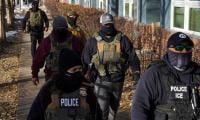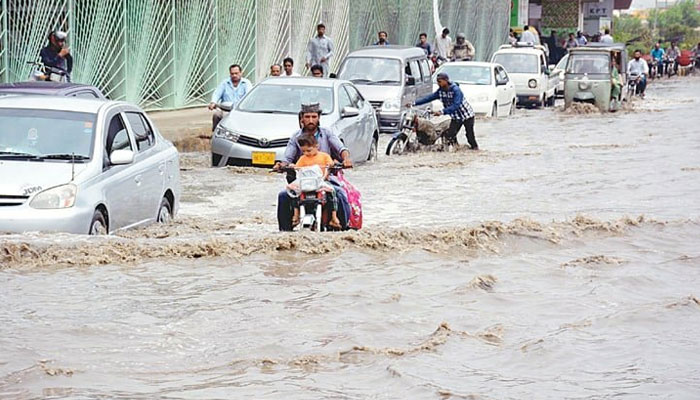Karachi suffers urban flooding as heavy rain lashes city
KARACHI: The dwellers of Karachi witnessed immense hardships on Friday when a brief but heavy spell of rain submerged many thoroughfares and low-lying areas of the city, causing traffic jams and depriving vast city areas of power while strong winds uprooted trees, poles and electrocuting two people, including an on-duty cop.
Just like an annual ritual, almost half of the Karachi’s roads and localities were flooded with sewage-mixed rainwater, many of the low-lying areas were reduced to pools of water as the choked storm-water drains and nullahs overflowed after rainfall on Friday afternoon. The gushing winds of the thunderstorm uprooted trees and electricity poles alarming people, who rushed towards their homes only to be caught up on the major roads representing cesspool littered with vehicles that had broken down.
The heavy downpour under the influence of a monsoon low pressure area (LPA) in the southeast of Karachi started in the afternoon following extremely hot and dry weather when mercury soared to 42.6 degrees Celsius in Karachi, which is the highest recorded temperature in Karachi in the month of July since 1958, the Pakistan Meteorological Department said. “The LPA later caused heavy downpour in the city,” said Sardar Sarfraz, Chief Meteorological Officer (CMO) of Pakistan Meteorological Department. Sarfraz said the areas around Sharae Faisal as well as Saddar, Landhi and Gulshan-e-Hadeed received the most rain. The areas adjoining the Sharae Faisal received the heaviest downpour, 63mm as recorded by the PAF Base Fasial observatory, followed by Saddar 41mm, and 40 mm in Landhi and Gulshan-e-Hadeed. Other city areas including the University Road and Jauhar area received 16mm, Jinnah Terminal, Nazimabad 9 and MOS Karachi received 28mm of rain. “The low pressure continues to hang in the southeast of Karachi where it is stationary and we are expecting hot and dry weather followed by some good rain on Saturday afternoon or evening,” Sardar Sarfraz said. The met officer forecast another monsoon spell in the city from July 25 to 27.
Tragically, two lives were lost as a result of snapping of wires and poles and turning of roads into cesspools due to choked drains. Those who lost their lives included policeman Arshad Ali of the Rapid Response Force who was deployed at a water pump where he was electrocuted. Another casaulty of electrocution was Abid Hussain who died near the Abdullah Shah Ghazi shrine in the Clifton locality.
Meanwhile, most of the main roads, thoroughfares and streets were inundated with rainwater-sewage mix during and after the rain. The three major underpasses including the Hotel Mehran Underpass, Drigh Road Underpass and KPT Underpass in Clifton were flooded with rainwater, causing major traffic jams. Thousands of vehicles were stuck on Sharae Faisal where one track of the road leading to Saddar was completely inundated with rainwater while commuters tried to use the other track, resulting in hours long breakdown of traffic and needless hardship. Motorcyclists were seen in particular misery, dragging their bikes in the knee-deep water.
Several people were seen struggling through in the fast flowing water after abandoning their broken down cars on the sides of roads. The rainwater had also accumulated on the M.A Jinnah Road, I.I Chundrigar Road, Aiwan-e-Saddar Road, adjoining streets and lanes. Trees and electricity poles were uprooted and flung on the road in front of Sindh Governor’s House blocking the traffic. Similarly, uprooted trees and poles littered the flooded University Road, Shahrah-e-Pakistan and Nishtar roads, causing major traffic jams. People from Defence, Clifton, DHA, PECHS, Bahadurbaad, Saddar, Garden, Jahangir Road and many other city areas complained of accumulation of knee-deep water in their areas, saying their cars and other vehicles had submerged and they were unable to go out in case of any emergency, fearing electrocution and drowning in the manholes.
Meanwhile, half a dozen cars were destroyed and many others were badly damaged when part of the Bandookwala building on I.I Chundrigar Road collapsed raining debris on the cars parked below. Also thousands of households were deprived of electricity following first drop of rainfall leaving people in different localities without electricity till the filing of this report late in the night. Some 500 feeders were affected due to rain, while many were switched off as a precautionary measure to prevent the people from getting electrocuted. Power was restored to some areas but some areas were still without power as the electricity supply network broke down which were being addressed.
-
 Jason Momoa Says Being With Beau Adria Arjona Feels 'perfect'
Jason Momoa Says Being With Beau Adria Arjona Feels 'perfect' -
 Idris Elba Says One Mix-up Nearly Cost Him A Knighthood From King Charles
Idris Elba Says One Mix-up Nearly Cost Him A Knighthood From King Charles -
 Andrew Mountbatten Windsor Incurs Anger Of Biggest Royal
Andrew Mountbatten Windsor Incurs Anger Of Biggest Royal -
 Megan Fox, Machine Gun Kelly's Relationship 'is Just About Co-parenting'
Megan Fox, Machine Gun Kelly's Relationship 'is Just About Co-parenting' -
 Prince Harry, Meghan Markle Warned They Can’t Fool Brits Because It Won’t Land
Prince Harry, Meghan Markle Warned They Can’t Fool Brits Because It Won’t Land -
 South Korea’s Ex-president Yoon Suk Yeol, Sentenced To 5 Years In Prison: Key Details Explained
South Korea’s Ex-president Yoon Suk Yeol, Sentenced To 5 Years In Prison: Key Details Explained -
 Princess Beatrice Is ‘terrified’ Of Mom Fergie: ‘She’s Begging Her To Not Destroy Her Future’
Princess Beatrice Is ‘terrified’ Of Mom Fergie: ‘She’s Begging Her To Not Destroy Her Future’ -
 Harry Styles’ New Album Earns Subtle Nod From Zoe Kravitz’s Dad
Harry Styles’ New Album Earns Subtle Nod From Zoe Kravitz’s Dad -
 Ari Emanuel Makes A Decision Regarding His Memoir Alongside Prince Harry’s Ghostwriter
Ari Emanuel Makes A Decision Regarding His Memoir Alongside Prince Harry’s Ghostwriter -
 Buckingham Palace Gives The Spotlight To The Duke And Duchess Of Edinburgh: Video
Buckingham Palace Gives The Spotlight To The Duke And Duchess Of Edinburgh: Video -
 Eva Mendes Revisits Year She Hid Pregnancy
Eva Mendes Revisits Year She Hid Pregnancy -
 Andrew’s Eviction Marks: ‘the End Of Grifting’: ‘It A Catastrophic Fall From Grace’
Andrew’s Eviction Marks: ‘the End Of Grifting’: ‘It A Catastrophic Fall From Grace’ -
 ASAP Rocky Disses Rihanna's Ex Drake In New Track
ASAP Rocky Disses Rihanna's Ex Drake In New Track -
 Jennifer Aniston, Jim Curtis Face One Major Hurdle In Their Union
Jennifer Aniston, Jim Curtis Face One Major Hurdle In Their Union -
 Restaurant Workers Detained After ICE Agents Dine At Minnesota Eatery
Restaurant Workers Detained After ICE Agents Dine At Minnesota Eatery -
 Kate Middleton Reveals Sport She Would Not Play With Prince George
Kate Middleton Reveals Sport She Would Not Play With Prince George




